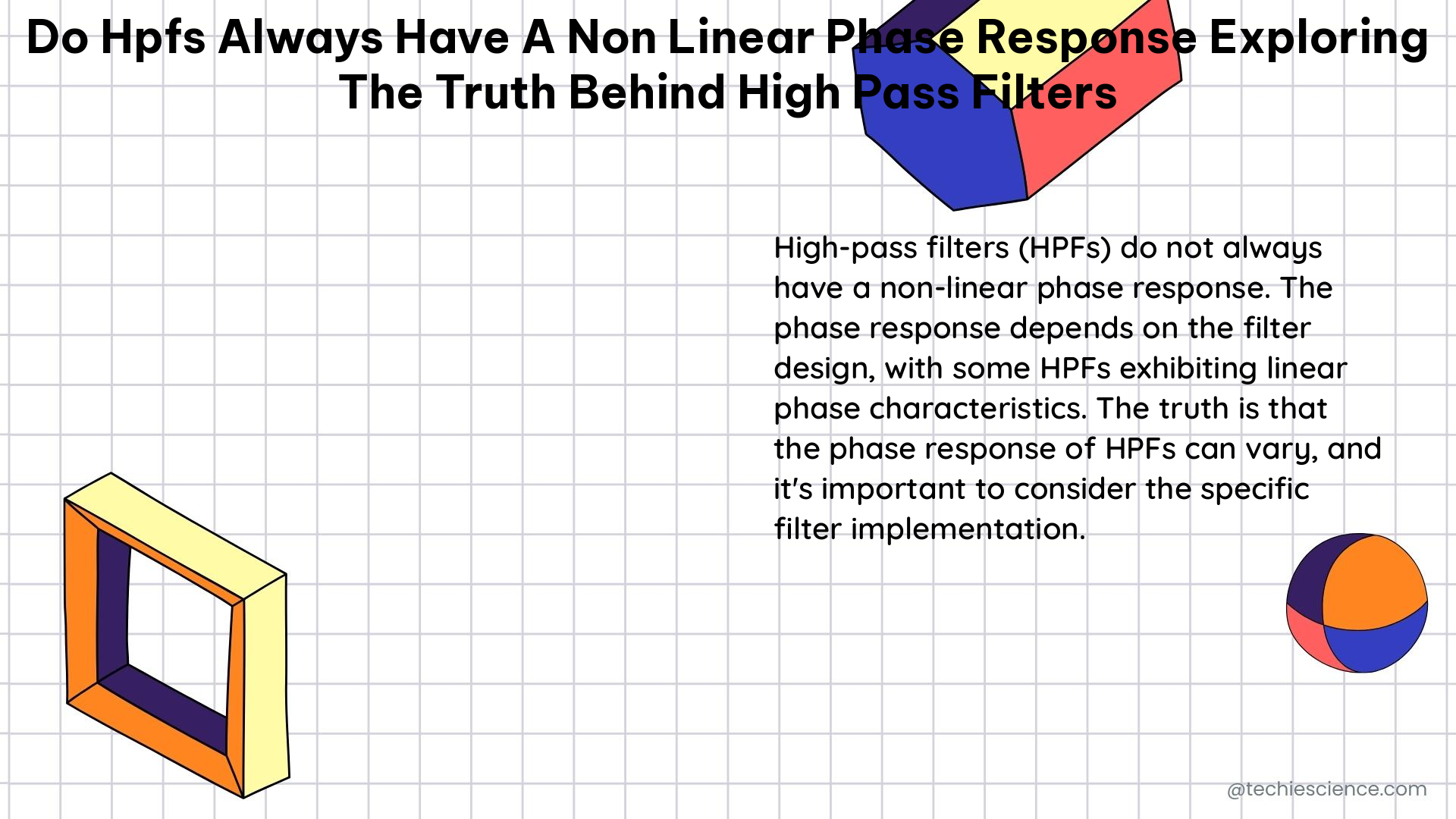High pass filters (HPFs) are a fundamental component in signal processing and electronic circuit design, used to remove unwanted low-frequency components from a signal. However, the question of whether HPFs always have a non-linear phase response is not a straightforward one, as it depends on the specific design and implementation of the filter.
Understanding the Phase Response of HPFs
The phase response of a linear time-invariant (LTI) system, such as an HPF, is determined by the ratio of the imaginary and real parts of the system’s transfer function. This relationship is described by the following theorem:
Theorem: The phase response of a linear time-invariant (LTI) system is given by the inverse tangent of the ratio of the imaginary and real parts of the system’s transfer function.
Mathematically, the transfer function of an ideal HPF is given by:
Electronics Formula: H(s) = s / (s + ωc)
where ωc is the cutoff frequency of the filter.
Electronics Example: Consider an HPF with a cutoff frequency of 100 Hz. The transfer function of this filter is:
H(s) = s / (s + 100π)
The phase response of this filter can be calculated using the inverse tangent formula:
φ(ω) = arctan(Im[H(jω)] / Re[H(jω)])
For ω = 50 Hz, the phase response is:
φ(50) = arctan(50π / (100π + 50π)) = 45 degrees
This example demonstrates that the phase response of an ideal HPF is non-linear, as the phase shift is not proportional to the frequency.
Linear Phase HPFs

While the ideal HPF has a non-linear phase response, in practice, HPFs are often designed to have a linear phase response. This is typically achieved by using a finite impulse response (FIR) filter design.
FIR Filters and Linear Phase Response:
– FIR filters are characterized by a linear phase response, meaning that the phase shift is proportional to the frequency.
– This linear phase response can help minimize distortion and improve the overall signal quality.
– However, it’s important to note that FIR filters can still have a non-linear phase response if they are designed using non-linear methods.
Non-Linear Phase HPFs
Despite the prevalence of linear phase HPFs, there are situations where non-linear phase filters can be beneficial. These filters can be designed using algorithms such as firlpnorm or cfirpm in MATLAB.
Non-Linear Phase FIR Filters:
– These algorithms allow for the design of FIR filters with non-linear phase responses.
– Non-linear phase filters can be useful in certain applications, such as when phase distortion is not a concern or when specific phase characteristics are required.
– However, it’s important to note that non-linear phase filters can introduce distortion and other signal quality issues, so they should be used with caution.
Data Points:
– The phase response of an ideal HPF with a cutoff frequency of 100 Hz is 45 degrees at 50 Hz.
– Non-linear phase FIR filters can be designed using algorithms such as firlpnorm or cfirpm in MATLAB.
Factors Affecting the Phase Response of HPFs
The phase response of an HPF can be influenced by several factors, including:
- Filter Design Methodology: The choice of filter design method, such as FIR or infinite impulse response (IIR), can impact the phase response.
- Filter Order: The order of the filter can affect the linearity of the phase response, with higher-order filters generally exhibiting more non-linear phase characteristics.
- Cutoff Frequency: The cutoff frequency of the HPF can also influence the phase response, with higher cutoff frequencies typically resulting in more non-linear phase behavior.
- Filter Topology: The specific topology of the HPF, such as Butterworth, Chebyshev, or Elliptic, can also affect the phase response.
Practical Considerations
When designing HPFs, it’s important to carefully consider the specific application and requirements to ensure that the filter is optimized for the desired performance characteristics. This may involve trade-offs between factors such as phase linearity, frequency response, and signal quality.
In some applications, a non-linear phase response may be acceptable or even desirable, while in others, a linear phase response is essential. By understanding the factors that influence the phase response of HPFs, engineers can make informed decisions and design filters that meet the specific needs of their applications.
Conclusion
In summary, the question of whether HPFs always have a non-linear phase response is not a simple one. While the ideal HPF has a non-linear phase response, in practice, HPFs can be designed to have either a linear or non-linear phase response, depending on the specific design and implementation. By understanding the underlying principles and factors that influence the phase response of HPFs, engineers can make informed decisions and design filters that meet the requirements of their applications.
References
- Linear Phase Filters and Frequency Response with the FabFilter Pro Q 2
- How to Design Nonlinear Phase FIR Filter?
- Nonlinear experimental modal analysis with RCT and the HFS concept
- Constant-force frequency response curves and backbone curve of the T-beam at different damage levels
- Experimental modal analysis of nonlinear systems by using the Hilbert-Huang transform and the random decrement technique

The lambdageeks.com Core SME Team is a group of experienced subject matter experts from diverse scientific and technical fields including Physics, Chemistry, Technology,Electronics & Electrical Engineering, Automotive, Mechanical Engineering. Our team collaborates to create high-quality, well-researched articles on a wide range of science and technology topics for the lambdageeks.com website.
All Our Senior SME are having more than 7 Years of experience in the respective fields . They are either Working Industry Professionals or assocaited With different Universities. Refer Our Authors Page to get to know About our Core SMEs.